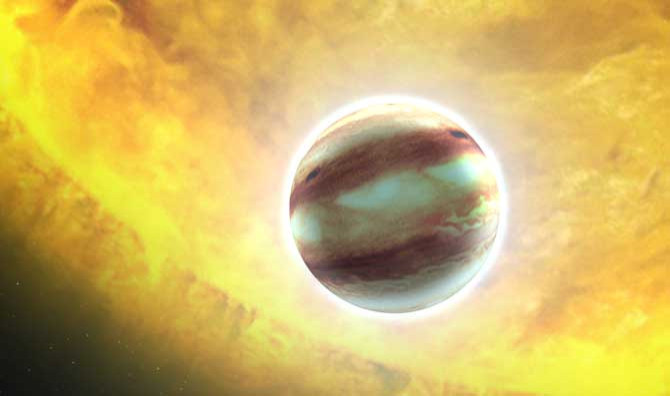Changeable weather on a giant exoplanet is observed for the first time
The hot gas giant planet HAT-P-7 b is a gas giant and could have enormous storm systems like Jupiter's.

The first hot gas giant planet outside our solar system to show weather patterns in its atmosphere has been spotted.
The gas giant planet HAT-P-7 b, which is similar to Jupiter in our solar system but larger, has an atmosphere that varies in brightness irregularly due to the weather events on the planet. HAT-P-7 b lies about 1,000 light years away from Earth.
The changes in atmosphere of an exoplanet are so subtle that it borders the capabilities of telescopes to pick up any changes due to weather. It is expected that gas giants similar to Jupiter would have weather events, such as strong winds, or even an equivalent to Jupiter's Great Red Spot, a storm system that is two to three times the size of Earth.
Astronomers used the Kepler spacecraft to observe HAT-P-7 b over four years in the visible light region of the electromagnetic spectrum, to monitor light reflected from the giant planet from the star it orbits.
The peak brightness of light reflected from the planet varied over periods of tens of days to hundreds of days. The irregularity of the changes suggested that this is due to unpredictable weather events rather than an artefact of how it orbits its star.
HAT-P-7 b orbits close to the star, and has a daytime temperature of about 1,900<sup>C.
"We suggest that variation in wind speed in the planetary atmosphere, leading to variable cloud coverage on the dayside and a changing energy balance, is capable of explaining the observed variation," the authors write in a paper on the findings, led by David Armstrong of the University of Warwick in the UK and published in the journal Nature Astronomy.
This is likely to be the first of many discoveries of weather on other planets, as instruments to detect the fine detail of atmospheric fluctuations on other exoplanets improve in sensitivity.
Future space missions to carry more sensitive instruments include Nasa's James Webb Space Telescope, and the ESA's Characterising Exoplanet Satellite and Planetary Transits and Oscillations of Stars missions.
© Copyright IBTimes 2025. All rights reserved.






















